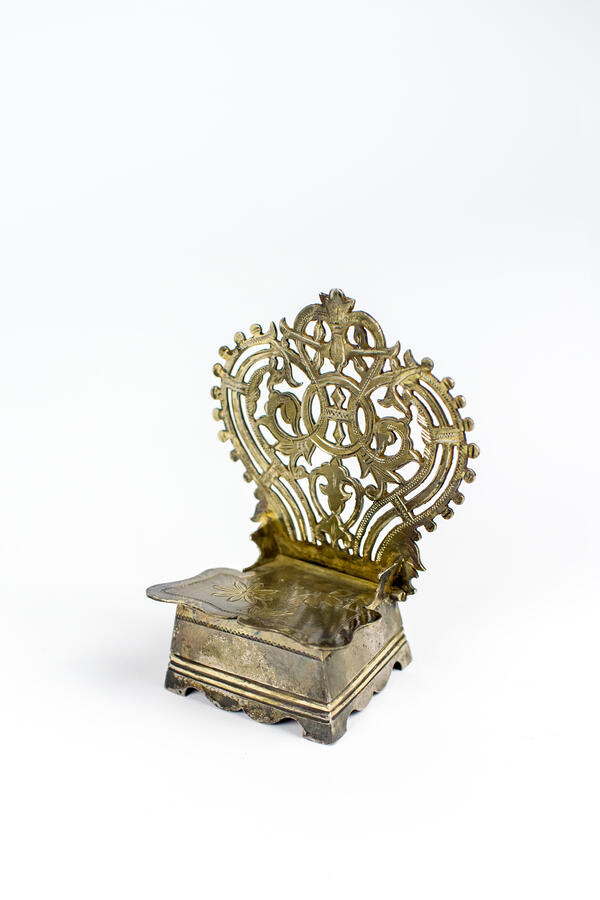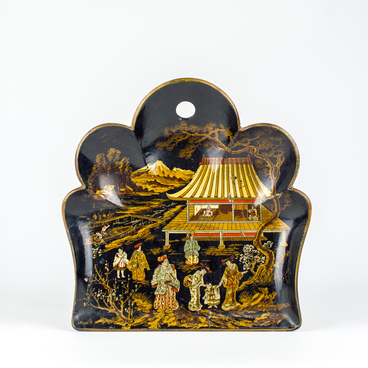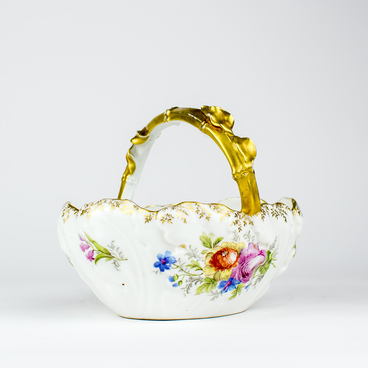The small silver saltcellar is made in the style of “trompe l’oeil”. This name comes from the French “trompe-l’oeil”, optical illusion. The saltcellar is made in the form of a throne with a high carved back and an opening seat.
The genre of “trompe-l’oeil” developed in antiquity. The best image was considered to be the one the viewer mistook for reality. Therefore, there were many legends about the rivalry of ancient painters in skill. For example, the story of the painter Zeuxis from Athens. In competition with Parrasius, according to the story of Pliny the Elder, Zeuxis painted a picture with grapes, “executed so successfully that birds began to fly on the stage.” In response, Parrasius presented a picture “with a canvas painted on it, reproduced with such fidelity that Zeuxis, became proud of the judgment of birds. Finally, he demanded to remove the canvas and show the picture, and realizing his mistake, gave up the palm, sincerely ashamed that he had misled the birds, and Parrasius — him, the artist.”
The decor of the saltcellar-throne is made in the Old Russian style, and the seat is decorated with an engraved floral ornament. At the head, the master’s brand, “VZM”, and an engraved female profile with a kokoshnik are preserved.
In Russia, saltcellars were mostly made of birch bark and clay. The salt was stored in them for a long time; it did not spoil and did not get soggy. Saltcellars came in different shapes, for example, duck-shaped ones were popular. According to legends, ducks protect treasures, and in the place where the wealth is buried, you can see the prints of duck paws. In Russia, salt was an expensive product and was considered the same treasure as, for example, a chest of gold.
Later, saltcellars began to be carved in the form of animals, barrels, thrones, Easter eggs, chests, chess pieces. As a rule, these containers consisted of two parts. The upper one was a lid that could be turned to the side or simply removed. The lower part was intended for the salt. Saltcellars were decorated with hollowed-out or burnt inscriptions. Wealthy people could afford saltcellars made of gold, silver, porcelain, glass.
Until the middle of the 19th century, the word “saltcellar” was used to describe boxes for storing salt and spices without holes in the lids. The familiar saltcellars, from which you can sprinkle a dish with salt, appeared only in the second half of the century.
The genre of “trompe-l’oeil” developed in antiquity. The best image was considered to be the one the viewer mistook for reality. Therefore, there were many legends about the rivalry of ancient painters in skill. For example, the story of the painter Zeuxis from Athens. In competition with Parrasius, according to the story of Pliny the Elder, Zeuxis painted a picture with grapes, “executed so successfully that birds began to fly on the stage.” In response, Parrasius presented a picture “with a canvas painted on it, reproduced with such fidelity that Zeuxis, became proud of the judgment of birds. Finally, he demanded to remove the canvas and show the picture, and realizing his mistake, gave up the palm, sincerely ashamed that he had misled the birds, and Parrasius — him, the artist.”
The decor of the saltcellar-throne is made in the Old Russian style, and the seat is decorated with an engraved floral ornament. At the head, the master’s brand, “VZM”, and an engraved female profile with a kokoshnik are preserved.
In Russia, saltcellars were mostly made of birch bark and clay. The salt was stored in them for a long time; it did not spoil and did not get soggy. Saltcellars came in different shapes, for example, duck-shaped ones were popular. According to legends, ducks protect treasures, and in the place where the wealth is buried, you can see the prints of duck paws. In Russia, salt was an expensive product and was considered the same treasure as, for example, a chest of gold.
Later, saltcellars began to be carved in the form of animals, barrels, thrones, Easter eggs, chests, chess pieces. As a rule, these containers consisted of two parts. The upper one was a lid that could be turned to the side or simply removed. The lower part was intended for the salt. Saltcellars were decorated with hollowed-out or burnt inscriptions. Wealthy people could afford saltcellars made of gold, silver, porcelain, glass.
Until the middle of the 19th century, the word “saltcellar” was used to describe boxes for storing salt and spices without holes in the lids. The familiar saltcellars, from which you can sprinkle a dish with salt, appeared only in the second half of the century.



